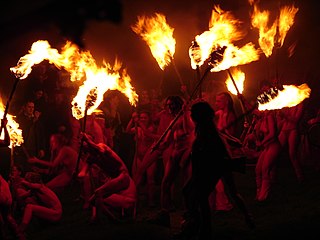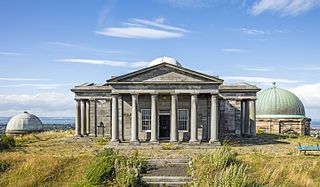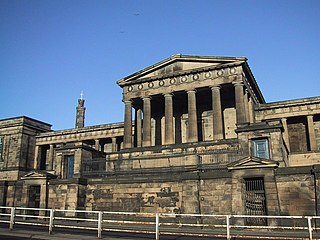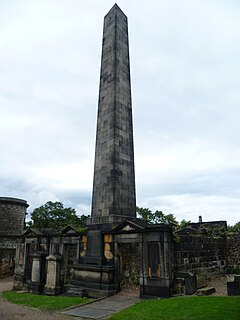 W
WCalton Hill is a hill in central Edinburgh, Scotland, situated beyond the east end of Princes Street and included in the city's UNESCO World Heritage Site. Views of, and from, the hill are often used in photographs and paintings of the city.
 W
WBeltane Fire Festival is an annual participatory arts event and ritual drama, held on 30 April on Calton Hill in Edinburgh.
 W
WCarlton Terrace is a residential street in Edinburgh, Scotland. It is located on the east side of Calton Hill, at the eastern extremity of the New Town, part of the UNESCO World Heritage Site inscribed in 1995.
 W
WThe City Observatory is an astronomical observatory on Calton Hill in Edinburgh, Scotland. It is also known as the Calton Hill Observatory.
 W
WThe Dugald Stewart Monument is a memorial to the Scottish philosopher Dugald Stewart (1753–1828). It is situated on Calton Hill overlooking the city of Edinburgh and was designed by Scottish architect William Henry Playfair. It was completed in September 1831.
 W
WThe Edinburgh Astronomical Institution was founded in 1811 and wound up in 1847. It was instrumental in the foundation of the Royal Observatory, Edinburgh in 1822. The Institution raised funds, mostly by member subscription, to create three departments: A scientific observatory with an observer was to be under the control of the professors of mathematics, philosophy and astronomy of the University of Edinburgh, a popular observatory was to provide general instruction and amusement and a "physical cabinet" would comprise books, globes, meteorological and other instruments.
 W
WGovernor's House is a building situated on the southernmost spur of Calton Hill, beside the south-east corner of Old Calton Burial Ground, in Edinburgh, Scotland. It looks out over Waverley Station, the Canongate and Holyrood Park to the south.
 W
WHill & Adamson was the first photography studio in Scotland, set up by painter David Octavius Hill and engineer Robert Adamson in 1843. During their brief partnership that ended with Adamson's untimely death, Hill & Adamson produced "the first substantial body of self-consciously artistic work using the newly invented medium of photography." Watercolorist John Harden, on first seeing Hill & Adamson's calotypes in November 1843, wrote, "The pictures produced are as Rembrandt's but improved, so like his style & the oldest & finest masters that doubtless a great progress in Portrait painting & effect must be the consequence."
 W
WThe National Monument of Scotland, on Calton Hill in Edinburgh, is Scotland's national memorial to the Scottish soldiers and sailors who died fighting in the Napoleonic Wars. It was intended, according to the inscription, to be "A Memorial of the Past and Incentive to the Future Heroism of the Men of Scotland".
 W
WThe Nelson Monument is a commemorative tower in honour of Vice Admiral Horatio Nelson, located in Edinburgh, Scotland. It is situated on top of Calton Hill, and provides a dramatic termination to the vista along Princes Street from the west. The monument was built between 1807 and 1816 to commemorate Nelson's victory over the French and Spanish fleets at the Battle of Trafalgar in 1805, and his own death at the same battle. In 1852 a mechanized time ball was added, as a time signal to shipping in Leith harbour. The time ball is synchronized with the One O'Clock Gun firing from Edinburgh Castle. The monument was restored in 2009.
 W
WNew Calton Burial Ground was built as an overspill and functional replacement to Old Calton Burial Ground and lies half a mile to its east on Regent Road in Edinburgh, Scotland, on the south-east slopes of Calton Hill. On its southern edge it attaches to the north-east edge of the Canongate in the Old Town. It lies on a fairly steep south-facing slope with views to Holyrood Palace, the Scottish Parliament Building and Arthur’s Seat.
 W
WThe Old Calton Burial Ground is a graveyard at Calton Hill, in Edinburgh, Scotland, to the north-east of the city centre. The burial ground was opened in 1718, and is the resting place of several notable Scots, including philosopher David Hume, scientist John Playfair, rival publishers William Blackwood and Archibald Constable, and clergyman Dr Robert Candlish. It is also the site of the Political Martyrs' Monument, an obelisk erected to the memory of a number of political reformers, and Scotland's American Civil War Memorial.
 W
WThe Old Royal High School, also known as New Parliament House, is a 19th-century neoclassical building on Calton Hill in the city of Edinburgh. The building was constructed for the use of the city's Royal High School, and gained its alternative name as a result of a proposal in the 1970s for it to house a devolved Scottish Assembly.
 W
WThe Political Martyrs Monument, located in the Old Calton Burial Ground on Calton Hill, Edinburgh, commemorates five political reformists from the late 18th and early 19th centuries. Designed by Thomas Hamilton and erected in 1844, it is a 90 ft (27 m) tall obelisk on a square-plan base plinth, all constructed in ashlar sandstone blocks. As part of the Burial Ground it is Category A listed.
 W
WRegent Bridge is a road bridge in Edinburgh, Scotland, where the A1 road enters the New Town from the east and passes over a hollow near Calton Hill. The bridge was built in the 19th century, in the neoclassical style as the medieval city was modernised and expanded to the north and east.
 W
WRegent Terrace is a residential street of 34 classical 3-bay townhouses built on the upper south side of Calton Hill in the city of Edinburgh, Scotland. Regent Terrace is within the Edinburgh New and Old Town UNESCO World Heritage Site inscribed in 1995.
 W
WRoyal Terrace is a grand street in the city of Edinburgh, Scotland, on the north side of Calton Hill within the New Town and part of the UNESCO World Heritage Site inscribed in 1995, built on the south side of a setted street, facing the sloping banks of London Road Gardens, formerly Royal Terrace Gardens, with views looking north towards Leith and the Firth of Forth.
 W
WSt. Andrew's House (SAH), on the southern flank of Calton Hill, Edinburgh, is the headquarters building of the Scottish Government. The building stands on the site of the former Calton Jail. Today, the turreted Governor's House is all that remains of the former prison, next to the Old Calton Burial Ground and Political Martyrs' Monument.